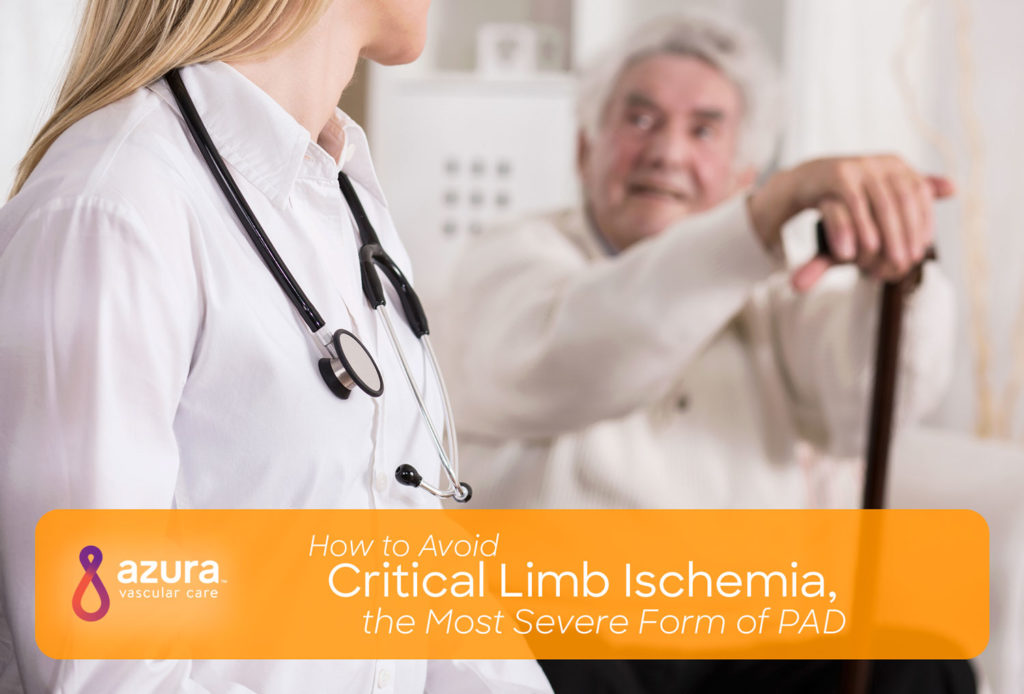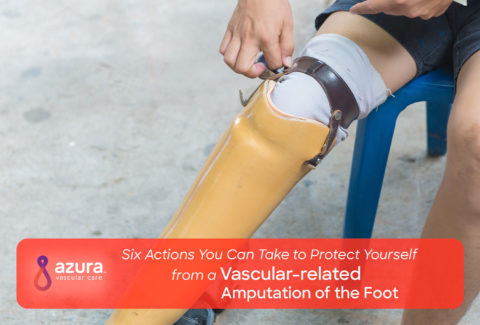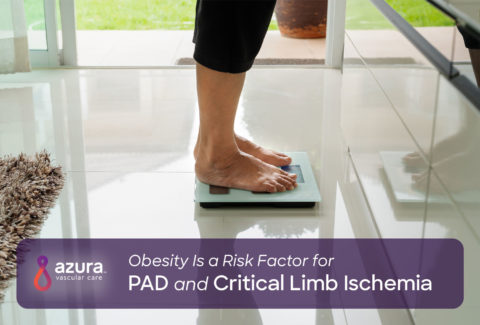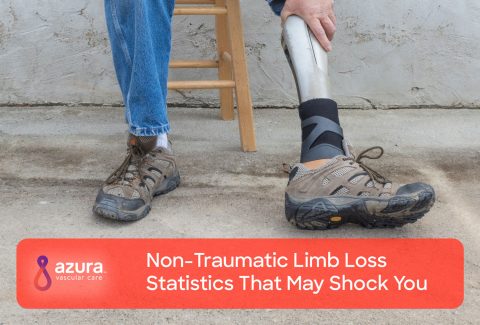
Critical limb ischemia is a severe arterial blockage in the lower extremities which, consequently, significantly reduces blood flow. It is the most severe form of peripheral artery disease (PAD), which occurs when arteries become narrow due to plaque build-up on the interior walls of an artery.
The mortality rate following diagnosis of critical limb ischemia exceeds 50 percent, which is higher than many cardiovascular diseases, including coronary artery disease. (i) Additionally, the rate of limb amputation can reach as high as 40 percent within six months following diagnosis. (i)
PAD is a progressive vascular disease without a cure, but PAD treatment is available and lifestyle changes may help stop the progression. If you have received a PAD diagnosis, take proactive steps now to avoid the devastating complications associated with critical limb ischemia. The following list may help lower your PAD risk factors.
Eight Ways to Avoid Critical Limb Ischemia
1. Stop Smoking
Smoking harms the lining of your arteries and leads to fatty buildup and narrowing of the vessel. In addition to critical limb ischemia, this narrowing can lead to a heart attack or stroke. The carbon monoxide from tobacco smoke diminishes oxygen in your blood. Your limbs and other vital organs need oxygen to survive. Smoking can significantly increase your risk for developing PAD, and eventually, critical limb ischemia. (ii)
If you have tried to quit smoking on your own and have been unsuccessful, contact your doctor. There are many therapies available to help you on your journey to quitting.
2. Lose Weight
Obesity contributes to many health complications, including:
- Type 2 diabetes
- High cholesterol
- High blood pressure
Consider the Mediterranean diet, rich in fruits and vegetables, olive oils, and legumes. This diet allows for fish but limits red meat. The Dietary Approaches to Stop Hypertension (DASH) diet is another preventative diet you can try. This diet calls for limited sodium and fat. Some studies suggest that this diet lowers hypertension and may stop the progression of cardiovascular disease. In other words, the DASH diet may promote better arterial health. (iii)
Contact your doctor to learn more about the best diet to help you lose weight and reduce your PAD risk factors.
3. Move More
Maybe you work in a job that has you sitting most of the time. Perhaps you are retired and spend hours on the computer catching up with friends and family on social media. To help prevent critical limb ischemia, it is important to move—exercise and get your blood flowing.
Assisted or supervised exercise is recommended, and walking is a great starting point. At first, walking may be painful, especially if you experience claudication (pain caused by poor circulation, usually during exercise), but this may go away or lessen over time.
Always speak to your doctor before starting any exercise program.
4. Control Diabetes
People with diabetes have a four times higher risk of developing critical limb ischemia compared with those who do not have diabetes. Diet and exercise, including the elimination of sugar, is a great way to help control insulin levels and keep your diabetes under control. (iv)
If diet, exercise or prescribed medications are not doing enough to control your insulin levels, see your endocrinologist.
5. Lower Cholesterol
Along with exercise, diet is the best way to reduce your cholesterol naturally, which decreases your risk of developing critical limb ischemia.
Consider the following dietary changes to help lower cholesterol: (v)
- Avoid trans fats—often found in margarine, cookies, cakes, and other foods that contain partially hydrogenated vegetable oils.
- Add more Omega-3 high foods—found in some types of fish and in walnuts.
- Cut down on saturated fats—found in red meat and some dairy products.
- Increase soluble fiber—found in oatmeal, apples, and pears.
- Incorporate whey protein—found in dairy products or in powder form.
Talk to your doctor before you make changes to your diet.
6. Lower Blood Pressure
Many of the listed items above—quitting smoking, losing weight, exercising—may contribute to lower blood pressure. Other actions to consider include:
- Decreasing coffee intake
- Avoiding alcohol
- Reducing stress
- Lowering salt intake
If your blood pressure is high, see your doctor.
7. Consider Age and Genetics
As you get older and if you have a family history of atherosclerosis or claudication, it is important to be proactive with your vascular health and see a doctor for assessment even if you do not have a PAD diagnosis. Advanced age also contributes to PAD risk factors.
8. Take Advantage of Treatment Options
If you or a loved one has been diagnosed with PAD, explore PAD treatment options. PAD is not curable, but intervention may help slow or stop progression, lower your risk for developing critical limb ischemia, and help restore your quality of life.
PAD treatment or procedure options include, but are not limited to:
- Angioplasty. During this minimally-invasive endovascular procedure, a balloon-tipped catheter is inserted through the artery using X-ray guidance. The balloon will be inflated to open narrowed or blocked arteries that supply blood to the legs.
- Stent Placement. A stent, or wire, mesh tube, is sometimes implanted during angioplasty to help keep the narrow artery open.
- Atherectomy. Instead of inserting a balloon during angioplasty, a small catheter tool is used to remove plaque from the narrowed blood vessel.
It is better to begin PAD treatment in its early stages to avoid the complications associated with severe PAD.
Severe PAD and Critical Limb Ischemia: What You Need to Know
If you suffer from PAD or severe PAD, it is important to recognize the symptoms of critical limb ischemia. These symptoms include:
- Shiny or excessively dry skin on the legs or feet
- Pain and/or numbness in the feet
- Toenail thickening
- Sores, skin infections, or ulcers on the leg that do not heal properly
- Inability to detect a pulse in legs or a weak pulse in legs
- Dry, gangrenous or blackened skin on the legs or feet
If you do not have a PAD diagnosis but have a family history of vascular disorders or circulation issues, advanced age, or other PAD risk factors like smoking, obesity, prolonged sitting, uncontrolled diabetes, high cholesterol, or high blood pressure, it is important to recognize the symptoms of PAD. These symptoms include:
- Cold lower leg or foot
- Weak legs
- Pain and/or cramping in one or both hips, thighs, or calf muscles after leg use
- Numb legs
- Sores on feet or legs that do not heal properly
- Hair loss or hair growth slowing on the feet and legs
- Slow growing toenails
- Shiny or smooth leg skin
- Change in leg color
- Inability to detect pulse on legs or weak pulse
If you have a PAD diagnosis, PAD risk factors or critical limb ischemia symptoms, call 866-534-3627 today to schedule an appointment with a vascular specialist.
Sources:
(i) Teraa M, Conte MS, Moll FL, Verhaaar MC. (2016). Critical limb ischemia: Current trends and future directions. Journal of the American Heart Association. Doi: 10.1161/JAHA.115.002938. https://www.ahajournals.org/doi/pdf/10.1161/JAHA.115.002938.
(ii) National Heart Lung and Blood Institute. Smoking and your heart. Accessed October 22, 2018, from https://www.nhlbi.nih.gov/health-topics/smoking-and-your-heart
(iii) Cleveland Clinic. Choose the best diet for your peripheral artery disease. Accessed October 22, 2018, from https://health.clevelandclinic.org/choose-the-best-diet-for-your-peripheral-arterial-disease/
(iv) Spreen MI, Gremmels H, Teraa M, et al. (2016). Diabetes is associated with decreased limb survival in patients with critical limb ischemia: Pooled data from two randomized control trials. _Diabetes Care _39(11):2058-2064.
(v) Mayo Clinic. Top 5 lifestyle changes to improve your cholesterol. Accessed October 22, 2018, from https://www.mayoclinic.org/diseases-conditions/high-blood-cholesterol/in-depth/reduce-cholesterol/art-20045935



